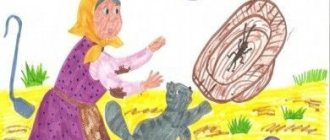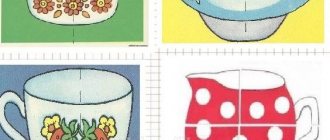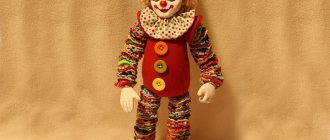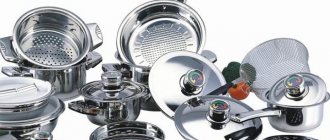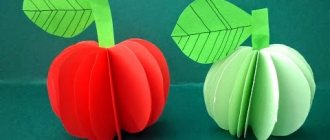What to do with a child when he is sick, or what interesting crafts for children can a kindergarten teacher come up with? In kindergarten, children often perform various tasks that help develop fine motor skills and imagination and are used for cognitive purposes.
To teach children to understand household items and tell them about the purpose of each item, a good option would be applique dishes , which are easy to do with a child of any age. It is enough to open our master class, designed for beginners, and step by step follow the recommendations indicated in it.
Tea sets for children made of colored paper
You can create many interesting crafts on the topic of dishes. Most of all, kids like variations with moving parts that they can play with. You can do this kind of work in a junior group, or in a middle group - in the end you should get a picture like this:
It is also suitable for preschoolers. The teapot in the kettle moves, you can also pour sugar with spoons and stir it.
To make such a miracle with your own hands, take cardboard, glue, colored paper and scissors. First you need to print a stencil on which the service will be glued, and prepare parts from colored paper - draw cups, spoons, a teapot with a teapot, cut them out along the contour. The step-by-step procedure is as follows:
- Make a tablecloth by gluing a beautiful design along the edges of the cardboard;
- Spread the blanks with glue along the edges and glue them to the base;
- Carefully insert the teapot and spoons.
Enjoy the result!
Summary of a lesson on application on the topic “Dishes” in kindergarten
- April 2, 2021
International and All-Russian competitions
Laureate of the All-Russian competition of pedagogical excellence “Methodological piggy bank of a kindergarten teacher”
Summary of a lesson in the second junior group of kindergarten on the topic “Utensils.”
Goal: To reinforce the names of utensils with children.
Tasks:
- Develop memory, attention, speech of children.
- Activate the dictionary on the topic: “Dishes”.
- Develop the ability to coordinate words in a sentence.
- To develop skills of cultural communication, hospitality, and friendliness.
GCD move
Educator: Guys, hello.
(There is a knock on the door. Winnie the Pooh enters the group and cries).
Educator: Good afternoon, Winnie the Pooh. What's happened? Why are you crying?
Winnie the Pooh. Good afternoon guys. How can I not cry? Today is my birthday. Eeyore, Piglet, Owl and Rabbit will come to visit me in the evening, and I have completely forgotten how to greet guests. Also, I don’t have any mugs in my house, because I broke the last mug this morning.
Educator: Winnie the Pooh, don’t be upset. The guys and I will definitely help you. Really, guys?
Children: Yes.
Educator: Guys, who knows what they usually treat guests to at birthday parties?
Children: Tea, sweets, cake, fruit.
Educator: Well done. Guys, let's show Winnie the Pooh how to properly set the table.
Children: First you need to cover the table with a beautiful tablecloth (demonstration). Then you should put the sugar bowl. It contains sugar. And this is a napkin holder. Napkins are placed in it to wipe your hands. And this is a candy bowl. You need to put candy in it.
Educator: That's right, but fruits can be put in a vase like this. It will look beautiful on the table. Guys, where will Winnie the Pooh put the cake?
Children: The cake can be placed on this spread.
Educator: Everything is correct. And for tea you need teaspoons (demonstrates), a teapot and mugs.
Guys, let's play a little with Winnie the Pooh.
Fizminutka
(Children form a circle. The teacher is in the center of the circle, reads the text and shows the movements that the children repeat) Knock - knock - knock, knock - knock - knock. (They knock their fists against each other.) A loud knocking sound is heard. A loud chime is heard. (They stomp their feet, hands on the belt). Ding-ding - dong, ding - ding - dong. It is in the kitchen that spoons, forks, cups, and ladle are dancing. (Tilt left and right arms with a shelf in front of the chest). Tra-ta-ta, tra-ta-ta All the dishes started dancing! (Perform a “spring”, hands on the belt). Kettle lid here, there! Spoons in a cup - knock, knock! And the pots - boom - boom! Frying pans - don - don! (“Dance”, alternately putting the left and right leg forward on the heel, hands behind the back). That's how the dance is - beauty! Tra-ta-ta, tra-ta-ta! (Clap their hands.)
Educator: Guys, did you like playing?
Children: Yes.
Winnie the Pooh: And I really liked it.
Educator: Guys, now I propose to make multi-colored mugs for Winnie the Pooh and his guests.
Children go to the tables. In front of each of them lies a ready-made mug made of colored cardboard. There are multi-colored circles on a plate. Children take a circle, smear it with a glue stick and place it on the circle in any order. Each child must glue 3 to 5 circles. The teacher and Winnie the Pooh help the children when they have difficulty.
At the end of the work, Winnie the Pooh and the teacher praise the children. Each child says what color his mug is and what color he pasted the circles (if the child has difficulty, other children help).
The teacher invites the children to give their mugs to Winnie the Pooh. Children are happy to give. Winnie the Pooh says “Thank you” and gives the children balloons. Children congratulate Winnie the Pooh on his birthday and sing “Loaf” to him. Winnie the Pooh says goodbye and leaves.
Educator:
- Guys, who came to visit us today?
- What happened to Winnie the Pooh?
- How did we help him?
- How did we congratulate the bear cub? What did he give us?
- What did you like most?
The work was presented by teacher Maria Aleksandrovna Druzhkova.
Bright cups-postcards
There are also more interesting designs for creating tea accessories that are suitable for children from 3 years old. They will be interested in creating, for example, a beautiful card for mom on March 8th with an applique on the theme of dishes - in this style: To make such beauty, you will need: white paper, a ready-made drawing or template, scissors, glue, colored pencils or paints. Then follow the instructions:
- Carefully cut out the heart and cup template.
- Fold the cup in half and bend the piece along two lines to make a saucer. You have created a beautiful applique – a cup on a saucer.
- Spread the saucer halves with glue and secure them.
- Glue a heart on top.
- Color the craft - for example, as in the photo. The gift is ready!
You can make such a surprise for a grandmother, sister, aunt or friend - in any case, the baby will be pleased to make such an applique himself.
Application “Plates for Fedora”
LESSON SUMMARY ON DECORATIVE APPLICATION Topic: “Plate for Fedora” Tasks:
— To develop children’s ability to place pattern elements in the center of a round shape and along the edges, combining them differently in color and shape. - Continue practicing cutting the square diagonally to get two triangles, cut a circle from the square, and an oval from the rectangle, gradually rounding their edges, cut the rectangle in the middle to get two squares. — Reinforce safety rules when working with scissors. — To develop aesthetic perception, the ability to see beauty. — Develop children's creativity. — Develop hand-eye coordination.
EQUIPMENT
: “Beautiful Dishes” slides, plates cut into pieces, cut out squares and rectangles on serving plates, white paper plates, glue stick, napkins, scissors, audio recording of calm music, tape recorder.
Move
Educator: - Guys, yesterday I was walking around the city and went into a store, there were such beautiful dishes in the windows that I couldn’t resist and started taking pictures of them, and now I want to show you these photographs.
(slide show)
There is a knock on the door. The postman comes in:
— Hello, receive the parcel and sign for it.
The teacher takes the parcel, the postman leaves.
The teacher draws the children’s attention to the colorfully decorated box, opens it and takes out a letter, the letter says “From Fedora.”
Educator:
Guys, this is a letter and a parcel from the same Fedora, from whom all the dishes ran away.
The teacher reads the letter: “Hello guys, I had a problem - all the plates broke. Woe, Fedora, woe!”
Educator:
Fedora's grief again The lesson didn't serve her well. There is no order in the house again, and again there is commotion.
All the dishes have broken. There are no plates, but the food is Fruits, vegetables, foodstuffs, all scattered all over the place!
Educator:
And there’s something else here! Guys, Fedora again took up the old ways - she didn’t spare the dishes, she broke all the plates, look, only the fragments remained (show the broken dishes).
Educator:
It’s a pity for Fyodor - she really loves to invite guests, but there are no plates. How can I help her?
(Problematic situation).
Suggested solution:
-Buy new plates.
- Give yours.
V. – But Fedora wants the plates to be exactly like the ones that crashed.
Children: - make new plates for Fedora.
V. – Of course. Your hands, although not very big yet, already know how to create beauty. You make the plates for her yourself, she will be delighted.
Then, go to our workshop, where everything is ready for work. But in order to make plates for Fedora, we must find out what patterns were on the broken plates. To do this you must put the pieces together.
Tear applique for developing fine motor skills
Making a cup
Among the many examples, there are also options that will interest older children. In a preparatory group, for example, you can do the following work - it will contribute to the development of communication abilities in children: You can independently find on the Internet and print ready-made samples - for example, if you have an average group, this option is preferable, because children of this age often lack perseverance. Hand out ready-made samples to the children and ask them to color them with pencils, markers or paints. At the same time, you can play out an interesting scene with a visit and preparing a table where everyone will have a cup of tea waiting for them.
Video: Making a jug
Target:teach children to look at a work of art - still life; bring children to an understanding of the unity of the content of the meaning of the picture and the means of expression found by the artist; develop children's ability to make aesthetic assessments; learn to draw kitchen utensils on various materials, cut out the outline and stick it on, observing the composition; reinforce the technique of cutting silhouettes from paper folded in half.
Material:
pencils, paper of different textures, foil, leather, fabric, etc.; glue, brushes, scissors, napkins, oilcloths; painting by I. I. Mashkov “Still Life with a Samovar”, stencils, tableware templates; samples of drawing dishes, kitchen utensils - rolling pin, board, sieve, slotted spoon, etc.
Preliminary work:
examination of V. Stozharov’s still lifes “Kvass”, “Flax”; reading the poem by K. Chukovsky “Fedorino’s grief”; excursion to a hardware store; modeling, painting dishes, etc.
Progress of the lesson
The teacher invites the children to look at I. I. Mashkov’s still life “Still Life with a Samovar.”
— Guys, admire this picture. Tell me, what mood does it evoke in you, happy or sad, calm or anxious? What do you think this picture is about?
- That's right, about household supplies, about dishes. What kind of dishes are shown here? (Kitchen.)
— I. I. Mashkov called his painting “Still Life with a Samovar.” Let's find the samovar in the picture. If a samovar could talk, what would it say about itself? (“I am the most important, big, beautiful!”) What color is the samovar? (Grayish-violet, steel, cold, shiny.) What else in the picture is painted in the same color? (Tray behind the samovar, lamp in front of it, jug, iron, pan lid.)
— Copper utensils stand out with bright spots: a brownish-yellow plate, in front of it is a reddish-brown teapot, on the left is a small yellowish mortar. To the left of the samovar is a small saucepan with a handle, a crimson box with a lid, on which stands a wooden bowl with Khokhlo painting. And in the very corner there is a tray with light yellow spots. The light falling from the window plays on the dishes.
In the picture we feel a clash of two color tones - cold (gray-gray-blue) and warm (brown-red, yellowish-orange, reddish-crimson). What color tones are there more? (Cold.)
“That’s why there is a feeling of anxiety.” The artist painted the picture in a very difficult time, cold, hungry. Empty dishes indicate this. The dishes seem to be cold. Objects seem to huddle together to keep warm. Now we are in a time of famine, and we will try to create our own still life, more cheerful. Our still life will also be composed of dishes. We use a technique - collage. This is gluing onto a base materials that differ in color, shape, texture.
1. Let's choose kitchen utensils that we like.
2. Let's draw the outlines of these objects.
3. If you wish, you can apply a dotted pattern to the objects or paint them.
4. Carefully cut out the object along the contour and place it on the sheet, then glue it.
As you work, you need to help the children, remind them of the techniques for cutting out silhouettes from folded paper. Ask what color scheme they decided to use. How did the still life turn out, sad or cheerful?
At the end of the work, an exhibition of still lifes is created.
Ideas for decorating tableware applications
Coffee applique
Looking for more challenging options? You can use not only paper - for example, here’s a work - appliqué of a cup of coffee from coffee beans:
Not quite childish, but if you look at it together with mom and dad, it will be interesting.
Fabric applique
In the older group, you can use pieces of multi-colored fabric for appliqué. For example, you can end up with these cute teapots:
The technique for making it is simple. It is enough to prepare the fabric - any will do, as long as it is colorful and not very thick - and stick it on the stencil along the pre-drawn outline.
Application made of colored paper and cotton wool
This type of application is suitable for young children. You need to make blanks that can be fashionably painted or decorated. The kid collects and glues the prepared elements and then makes steam from the cotton wool.
Children's applique – Teapot and teaware
I suggest you consider a composite applique made of cardboard and colored paper “Teapot”.
For kids, you need to cut out all the necessary details in advance, and children 5-6 years old will be able to do it themselves, using downloaded template files from our website, and for decoration - a visual example of a picture of a teapot.
In this application I used my own template. For you and your child, we have drawn printable files “Teaware”. The set of files consists of templates: teapot, mug, saucer, teaspoon, pie dish. I believe that such templates will be of help to educators in children’s educational institutions. Let's first look at making a simple version of the applique for five-year-old children.
To apply the teapot we will need:
• Colored cardboard; • Template of teapot parts; • Colored paper; • Album (1 sheet for the base); • Glue; • Scissors; • Pencil.
Attention! The child must do the craft entirely himself. Your task is to control, explain and give hints.
MANUFACTURING PROCESS.
Using the template, we will transfer the details of the teapot onto cardboard. The base of the teapot is yellow, and the spout, handle, bottom and part of the lid are red. Photo-1.
Carefully cut out all the parts of the teapot. Photo-2.
At this stage, you can invite your child to make a teapot from parts themselves.
This task develops a holistic perception of the subject.
If the child is at a loss, offer him a sample as a hint. Photo-3.
Let's start assembling the teapot.
We will use a landscape sheet or a sheet of white cardboard as a base for the applique.
First, glue the container itself (circle), then glue the part of the teapot spout to it.
All that's left is to glue the handle! Photo-4.
Next we glue the red bottom of the teapot and the first part of the lid.
At the end, we glue the last part of the lid and the circle - the handle. Photo-5.
The base of the teapot is ready! To decorate the pot-bellied teapot, cut out several circles from colored paper. Photo-6.
Now let's decorate the teapot to your taste with multi-colored circles - peas, arranging them randomly, or making up your own pattern from them. Photo-7.
(
Templates come with decorations such as stickers or decals.
).
We have a bright and elegant teapot! Please bring some cups - we'll drink tea!
How to make a flat object visually voluminous?
In this joint work, we are examining not only the topic “Dishes”. The teapot is pot-bellied, remember?
And after completing the craft, you should definitely draw the children’s attention to this word. Such a word will amuse them and arouse visual interest.
In our application example, and of course, in the template files, attention is paid to highlighting (giving) volume to flat parts. After all, visual volume is created not only by details, but also by their location in an application or drawing.
This makes the object look flat. Let's attach an oval-shaped part. So what's going on? A flat object, as if by magic, looks three-dimensional (round, like an inflated balloon).
Why is the oval black? Black color can mean emptiness, and we may have coffee or tea in our cup. What's in the kettle? Black tea is brewed in a very hot kettle. Be careful!
For children, this is the simplest, most understandable and visual explanation. In their next creative works, they will definitely try to make their own appliqué or drawing with a volumetric effect. In any case, they will definitely want to experiment!
Download “Teaware” file templates.
ONLINE VIEW: tableware.pdf
— If you do not have a program for reading PDF files (Russian version), download it from the official website. — Free program “ Adobe Acrobat Reader DC”
» — A program for reading, printing and reviewing PDF files.
The files are distributed free of charge in electronic PDF format, and only on the website www.asreda.com.
Not for commercial use. Article on the topic: “ Samovar template for applique .”
Article on the topic: “ Finger Theater. Felt geese ."
Article on the topic: “ Sew a phone from felt and learn numbers .”
__________________
© Anastasia Obolentseva, for www.asreda.com
Collective application “Tea drinking with a samovar”
This is a great idea for a collective applique, when each of the children comes up with their own design and decorates the cup.
The samovar is practically not used today; it is a rare, ancient, but nice object that reflects the spirit of the times. The process of creating from colored paper, fabric or any other available material will delight the kids. The samovar can be combined with a tea set.
A detailed description of the work process is as follows:
- Make preparations (cups, bagels, samovar).
- Take whatman paper and cover it with napkins - you’ll get a tablecloth.
- Then place a cut out samovar on it with a bunch of bagels glued on.
- Let children choose a color for the cup, color them, and cut and glue them.
